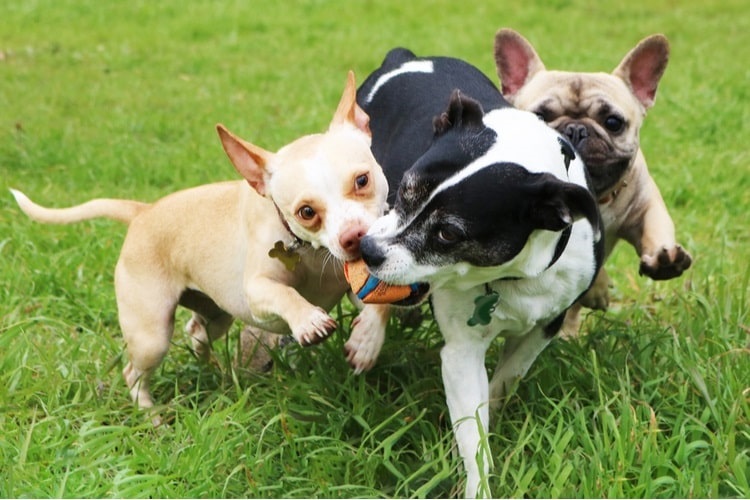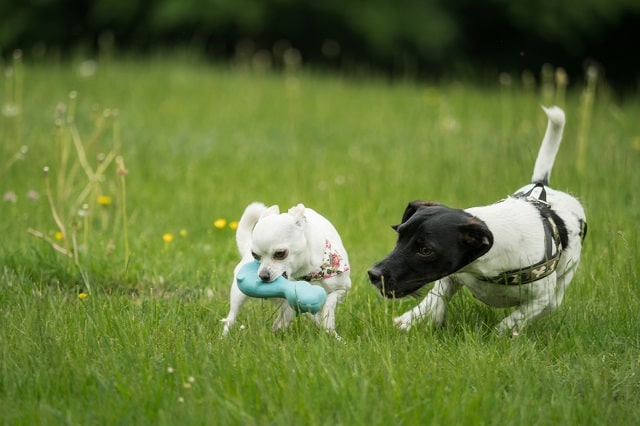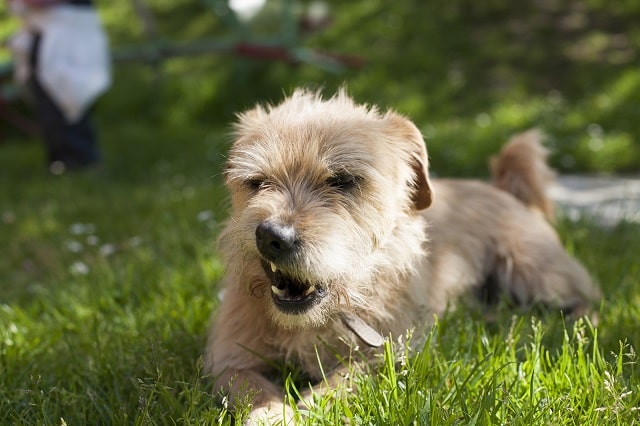Whether your dog doesn’t get along with other dogs or rarely gets into fights, every dog owner should know how to stop dogs from fighting so you’re prepared should it ever occur. There are a variety of reasons that dogs may fight, from protectiveness to resource guarding to too much (or too little) stimulation. Here’s what you need to know about why dogs fight and how to stop dogs from fighting.
Why Do Dogs Fight?
Dogs fight for a variety of reasons. Most of the time, fighting has an underlying cause. Though there are a few bad apples out there who may fight for no reason, that is the exception, not the rule.
We used to discuss a dog’s pack mentality and some inherent need to belong to a social structure or hierarchy. People thought motivation for behavior was to earn a higher “place” in that hierarchy. Over the past 20 years, this philosophy and theory have been disproven. We have a better understanding of dog behavior today, allowing us to better interpret their impending actions. And it has become very apparent that most dogs fight in response to a threat or external stimulation that they feel is a threat.1
When discussing strategies to stop dogs from fighting, we need to learn a bit about why dogs fight. This requires a better understanding of signs of aggression, anxiety, and fear in dogs and learning proper strategies to prevent clashing. By recognizing these signs ahead of time, you can learn to diffuse a situation. You should also know how to stop fighting if it occurs and how to remain safe in the event of a fight.
6 Strategies to Stop Dogs from Fighting
Step 1: Know Key Triggers for Fighting
Understanding the factors contributing to fighting can help you know your dog’s behavior and anticipate a problem before it occurs. It can also let you identify triggers for your pet. You can then learn to avoid the triggers or work on positive training cues that will refocus your dog’s attention and allow you to prevent a fight.
Dogs may become aggressive with dogs they know, such as a housemate or playmate, or a stranger. The reasons for fighting may include:
Protecting Behavior/Resource Guarding
This can arise when a dog is protecting their property or territory (i.e., a strange dog in your yard)2 or another animal or human in the family.3 A dog may also display aggression when protecting food or prized possessions, such as toys or balls.45
Overstimulation/Excitement
Why would getting excited or playing too much cause aggression? This occurs when they get super aroused. They do not have an outlet to expel excess energy. Some dogs run around doing zoomies, others eat things they shouldn’t, and yet others will fight with the first dog they see.6 Overstimulation can occur when engaging in everyday activities or with new events.
Understimulation
While too much stimulation can provide sensory overload and stress, the opposite is just as true. Lack of exercise, mental stimulation, or physical contact with family members can also lead to aggressive behaviors.
Redirection (Redirected Aggression, Anxiety, or Fear)
Redirection can occur when the animal acts out on the closest thing to them. For example, UPS rings the doorbell. The dog can’t get to the delivery person but can go attack his housemate nearby.7 This is a common cause of interhousehold aggression.8
Attention Seeking
Dogs may display aggression when seeking attention because their owners are paying attention to another pet or a child in the home or when non-family members are present in the home.9
Underlying Medical Reason
Dogs who are in pain or sick may show it in a variety of ways. If aggression develops, have your pet evaluated by a veterinarian to rule out underlying medical reasons.
Not All Dogs Like Other Dogs
Just like humans don’t always get along with one another, some dogs simply don’t like other dogs at all, or a dog may dislike a particular dog. 10
No Trigger At All
Though the exception, not the rule, some dogs are innately more likely to be aggressive to other dogs. However, likely there is still a trigger we just didn’t witness.11
Step 2: Recognize Signs of an Impending Fight
By recognizing signs of anxiety or fear before your pet escalates to fighting, you can stop fighting in its tracks. By learning to recognize the differences between regular play vs. aggressive play, you can monitor for escalation. To do this, we need to discuss some of these normal behaviors.
Signs of Play and Relaxation in Dogs
Knowing what behaviors are normal during play is crucial. When dogs play together, they will often bite or nip around the neck and jump up on each other, but their bodies will remain loose; they may play bow. They’ll have relaxed ears and eyes when playing.12
See Table 1 for some common behaviors shown by a relaxed dog.
TABLE 1: Signs of content, calm dog, even playful dogs. Adapted from Canine and feline behavior and handling13 and Animal Behavior and Rabies.14
Signs of Fear, Stress, or Anxiety in Dogs
Stressed dogs often show subtle signs that may alert you that play or other behavior changes to something of concern.
A dog can go from playful to aggressive with what seems like the flip of a switch. You may not understand the switch or even witness it, but if you can recognize signs of stress and take action, you can prevent a fight from happening.
See Table 2 for communication cues expressed by dogs who are stressed and anxious.
Table 2. Behavioral indicators of stress and anxiety. Adapted from Canine and feline behavior and handling15 and Animal Behavior and Rabies.16 with additional resources from Bites Bite! Avoid Being Bitten in This Field!17
Signs of Impending Aggression – “Fight Preparation”
Signs of impending aggression may vary depending on the dog. Some dogs may show some of the stressed or anxious behaviors listed above and then may suddenly, with what seems like no warning, attack. However, most of the time, there are subtle shifts that occur. We just have to learn to recognize them.
These changes can be to overall body position, ear position, tail position, body tension, even a shift in the eyes or mouth.18 You may see them raise their hackles. This is when the fur stands up on their back, making them look bigger. They may even growl/vocalize before attacking another dog. Finally, if the dog is barking, the bark’s tone may alter slightly, becoming deeper or more intense.19
Step 3: Don’t Put Your Dog in a Position to Fail
Take steps to minimize the risk of a fight even arising.
Stranger Fighting
- CONSIDER tying a visible yellow ribbon around your dog’s neck/collar/leash.20
- This will alert others to approach your dog with caution, or ideally not at all.
- It can be used for aggressive dogs, fearful dogs, training dogs, dogs with exercise restrictions or arthritis, and not just dogs who fight.
- It serves as a caution warning to others, saying to stay clear.
- Avoid dog parks or heavily populated walking routes. Go for walks at off hours of the day to minimize exposure.
- Use an escape proof harness (read our review of escape proof harness) to ensure that you can keep control of your dog.
- Always be alert for animals or other triggers for anxiety. Turn and walk your dog the other way.
- Ensure the pet is confined in a physical (not invisible) fenced-in yard at home or only on a leash when off property.
Interhousehold Fighting
The best way to try and stop dogs from fighting in your home is to maintain a consistent routine. Ensure all social interactions are predictable and comfortable for all animals involved.21 Consider the following additional items to minimize fighting.
- Avoid having 2 females or 2 males; rather, one of each may be less likely to fight.22
- Do not allow pets to share crates. Place crates so dogs cannot see each other.23
- Keep them in separate rooms or parts of the house when you are not home.
- Allow the dogs only short playtime together, making sure that they take breaks independently. Allow 2-5 minutes of rough play, and if they do not disengage on their own, then distract them or encourage separation.
- Always feed separately. (Own dishes, own rooms, different times of day, whatever works).
- If fighting occurs most commonly when you first arrive or depart, ignore your pets for the first 10-30 minutes upon arrival and before leaving. Sounds counterintuitive, but they are less likely to be so excited, and it lessens the chance of redirected aggression. The sooner the dogs settle, the sooner they get the attention they seek. They are not rewarded for being too excited or hyper.2425
- Walk scared or anxious dogs separately from those who are more likely to fight. This minimizes distractions for you both, increasing the likelihood of a successful stress-free walk. Any stressor could trigger displaced feelings and manifest as fighting if dogs are walked together.
Step 4: Always Remain Calm
Dogs are very good at reading human emotions. So if you are stressed, they will sense it. If you scream and yell at them and are loud and boisterous because you see another dog coming in the distance, you are only going to increase that pet’s own anxiety and stress level.26
When you see a subtle shift in your dog’s behavior or you see that dog across the street, remain calm. Project calmness and confidence to your pet but speak in a normal tone and reassuringly to your dog.
By yelling and screaming, you only increase the chance that the dog will react, thinking there is a threat. To some dogs, remember, threat equals a fight response.27
Step 5: Provide Sufficient Exercise and Mental Stimulation for Your Pet
Always ensure that your dog gets enough exercise. Leash walks, running around a yard, playing at a park are essential for exercise. But don’t forget mental stimulation like sniffing time, food toys and puzzles, dog training such as cooperative care, and more. Failing to stimulate the mind can lead to boredom and acting out behaviors.28
Step 6: Know How to Safely Break Up a Fight in the Event One Occurs
- You can consider:29
- Throwing a blanket over them or between them
- Throwing water over them
- Using a loud distracting noise like a foghorn, whistle, or symbol. There are phone apps that you can use to create odd sounds.
- Use a heavy enough object such as a chair that can keep you protected but could get between them.
- For more detailed suggestions on how to break up a dog fight, see this link by an emergency veterinarian Tony Johnson, DVM, DACVECC.
A Few DOS AND DON’TS To Always Keep in Mind
- DO learn to recognize cues.
- Know your dog.
- Recognize what stresses your dog.
- Suppose you are on a walk, and the dog starts to get tense, ears erect, pulling towards another animal. Then you can redirect attention with treats or a favorite toy and walk the other way.
- Don’t put you or your dog in a situation that could escalate to a fight.
- DO know your environment and where problems may arise.
- A specific house on a walk with a dog inside a fenced in yard
- The Amazon delivery driver coming to the door
- When you first come home from work and both dogs greet you at the door
- DO INTERVENE
- For dog siblings, supervise play.
- If play becomes too rough, the dogs aren’t taking breaks every few minutes on their own, or their body language changes, intervene. Get their attention and change their focus.
- If body posture or alertness shifts during play, try calling their names and distracting them.
- If they do not respond to sounds and happenings around them, they may be too hyper-focused. You should stop play for a bit.
- For strangers, make sure, as above, you are familiar with your surroundings, and you have an alternate route or plan.
- For dog siblings, supervise play.
- DO separate dogs when you aren’t home and only allow short, supervised play.
Remember that aggression often occurs in response to some external situation that scares the dog or overstimulates them. Still, some dogs just don’t like other dogs. These dogs, you simply must avoid interactions with other dogs, period.
Too Late, They Fought. Now What?
- DON’T attempt to break up two dogs by putting yourself in the middle. You will get hurt.
- During a fight, your dog isn’t thinking about mom or dad, no matter how gentle your dog is with you. The adrenaline is sky high, and the fur is flying. You WILL get bitten.
- DON’T kick, beat, or otherwise use instruments to hurt the dogs. Not only can this hurt them, but it also can cause them to redirect their aggression onto you.30
Sometimes, however, you cannot prevent fighting 100% of the time. If a fight ensues, once the dogs are apart, get space between you, so they are out of sight and out of mind. Then thoroughly check your dog for any apparent open wounds, blood, soreness, but do so tenderly. If painful, the pet may bite you inadvertently.
Even if you don’t find any wounds, that doesn’t mean they aren’t there. Sometimes it can take time for the wounds to become evident. So do not delay care. Waiting even 24 hours can allow pain and infection to set in. So, after a fight, even if wounds aren’t evident, seek care from your veterinarian.
Finally, always ensure your pet’s rabies vaccine is up to date. Suppose you do not know the dog’s vaccine status the pet was fighting. In that case, it is safer to assume the dog is unvaccinated and get your pet’s rabies vaccine boostered.
Final Thoughts
You can still enjoy long walks, the park, playing with your dog, and much more, even if dog fighting concerns exist. Just take care to do it with preplanning. Know your dog and watch for subtle body language changes that may suggest your dog may become aggressive. Provide proper enrichment and activities to ensure your dog has suitable outlets for energy and prevent built-up frustrations. It may take some effort, but with planning, training (of both you and your dog), and patience, most of the time, we can stop dogs from fighting.
In addition to helping you address issues with dogs fighting, we have a number of other resources dedicated to your dog’s well being. You can check out our guide to choosing the right vet recommended dog ear cleaner for your pup, our list of the best dog hair dryer, and our run-down of the best dog clippers for poodles.
Additional Resources
- Yellow Ribbon around the collar, leash, neck. For more information, visit:
- Body Language of Fear in Dogs. An image demonstrating various signs of fear in dogs. (Originally adapted from Dr. Sophia Yin, 2015.)
- If your dog is aggressive, being able to safely apply a muzzle is an asset. Muzzle use training: The Muzzle Up Project aims to educate and train on the safe use of muzzles and animal behavior.
- Understanding your dog’s body language
Article Sources
Pet News Daily uses only high-quality sources, including peer-reviewed studies, to support the facts within our articles. Read our editorial process to learn more about how we fact-check and keep our content accurate, reliable, and trustworthy.
- Dumb Friends League. Understanding Aggressive Behavior in Dogs. Ddfl.org. Accessed April 19, 2021.
- Stregowski J. How to Stop Your Dog From Fighting. The Spruce Pets. Published 2019. Accessed March 29, 2021.
- Calder C. Aggression Between Familiar Dogs. Veterinarypartner.vin.com. Published December 21, 2020. Accessed March 29, 2021.
- Stregowski J. Why Do Dogs Fight? The Spruce Pets. Published 2019. Accessed March 29, 2021.
- Feltes ESM, Stull JW, Herron ME, Haug LI. Characteristics of intrahousehold interdog aggression and dog and pair factors associated with a poor outcome. J Am Vet Med Assoc. 2020;256(3):349-361. doi:10.2460/javma.256.3.349
- Stregowski J. How to Stop Your Dog From Fighting. The Spruce Pets. Published 2019. Accessed March 29, 2021.
- Stregowski J. Why Do Dogs Fight? The Spruce Pets. Published 2019. Accessed March 29, 2021.
- Wrubel KM, Moon-Fanelli AA, Maranda LS, Dodman NH. Interdog household aggression: 38 cases (2006–2007). J Am Vet Med Assoc. 2011;238(6):731-740. doi:10.2460/javma.238.6.731
- Wrubel KM, Moon-Fanelli AA, Maranda LS, Dodman NH. Interdog household aggression: 38 cases (2006–2007). J Am Vet Med Assoc. 2011;238(6):731-740. doi:10.2460/javma.238.6.731
- Stregowski J. Why Do Dogs Fight? The Spruce Pets. Published 2019. Accessed March 29, 2021.
- Wrubel KM, Moon-Fanelli AA, Maranda LS, Dodman NH. Interdog household aggression: 38 cases (2006–2007). J Am Vet Med Assoc. 2011;238(6):731-740. doi:10.2460/javma.238.6.731
- McCawley J. Dog Behavior 101: Playing or Fighting. Published May 14, 2019. Accessed April 19, 2021.
- Tramuta-Drobnis E. Canine and feline behavior and handling. PowerPoint Presentation presented at the: Lehigh Valley County Animal Response Team; May 21, 2019a; Allentown, PA. Unpublished.
- Tramuta-Drobnis E. Animal Behavior and Rabies. PowerPoint Presentation presented at the: Allentown Bureau of Health; November 20, 2019b; Allentown, PA. Unpublished.
- Tramuta-Drobnis E. Canine and feline behavior and handling. PowerPoint Presentation presented at the: Lehigh Valley County Animal Response Team; May 21, 2019a; Allentown, PA. Unpublished.
- Tramuta-Drobnis E. Animal Behavior and Rabies. PowerPoint Presentation presented at the: Allentown Bureau of Health; November 20, 2019b; Allentown, PA. Unpublished.
- Newfiel A. Bites Bite! Avoid Being Bitten in This Field! VIN.com. Published 2011. Accessed April 16, 2021.
- American Kennel Club. Are They Playing or Fighting? A Guide to Evaluating Rough Pup Play. Akc.org. Published May 9, 2019. Accessed April 19, 2021.
- ASPCA. Aggression. Aspca.org. Accessed April 19, 2021.
- Tractive GPS. What does a yellow ribbon on a dog’s collar mean? Tractive Blog. Published June 30, 2017. Accessed March 29, 2021.
- Horwitz D, Landsberg G. Dog Behavior Problems – Aggression – Sibling Rivalry – Treatment. Vcahospitals.com. Accessed April 19, 2021.
- Feltes ESM, Stull JW, Herron ME, Haug LI. Characteristics of intrahousehold interdog aggression and dog and pair factors associated with a poor outcome. J Am Vet Med Assoc. 2020;256(3):349-361. doi:10.2460/javma.256.3.349
- Calder C. Aggression Between Familiar Dogs. Veterinarypartner.vin.com. Published December 21, 2020. Accessed March 29, 2021.
- Horwitz D, Landsberg G. Separation Anxiety in Dogs. Vcahospitals.com. Published 2021. Accessed March 30, 2021.
- Bloom I. When Are You Coming Home? How to Ease Separation Anxiety | Karen Pryor Clicker Training. Karen Pryor Clicker Training. Clickertraining.com. Published 2011. Accessed March 30, 2021.
- Dumb Friends League. Understanding Aggressive Behavior in Dogs. Ddfl.org. Accessed April 19, 2021.
- Stregowski J. Why Do Dogs Fight? The Spruce Pets. Published 2019. Accessed March 29, 2021.
- TLC Animal Hospital. Aggression Between Family Dogs. Tlcvetelpaso.com. Published January 20, 2017. Accessed April 19, 2021.
- Stregowski J. How to Stop Your Dog From Fighting. The Spruce Pets. Published 2019. Accessed March 29, 2021.
- Johnson T. The Safest Way to Break up a Dog Fight. Vin.com/vetzinsight. Published March 5, 2018. Accessed April 16, 2021.






